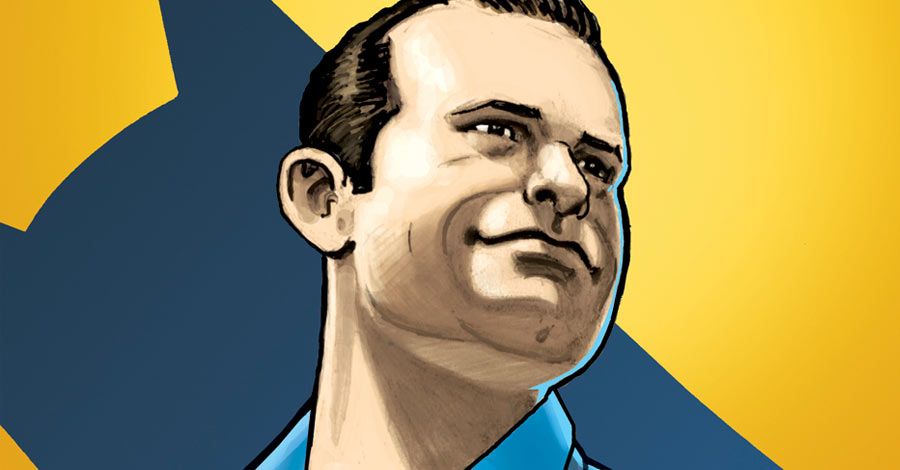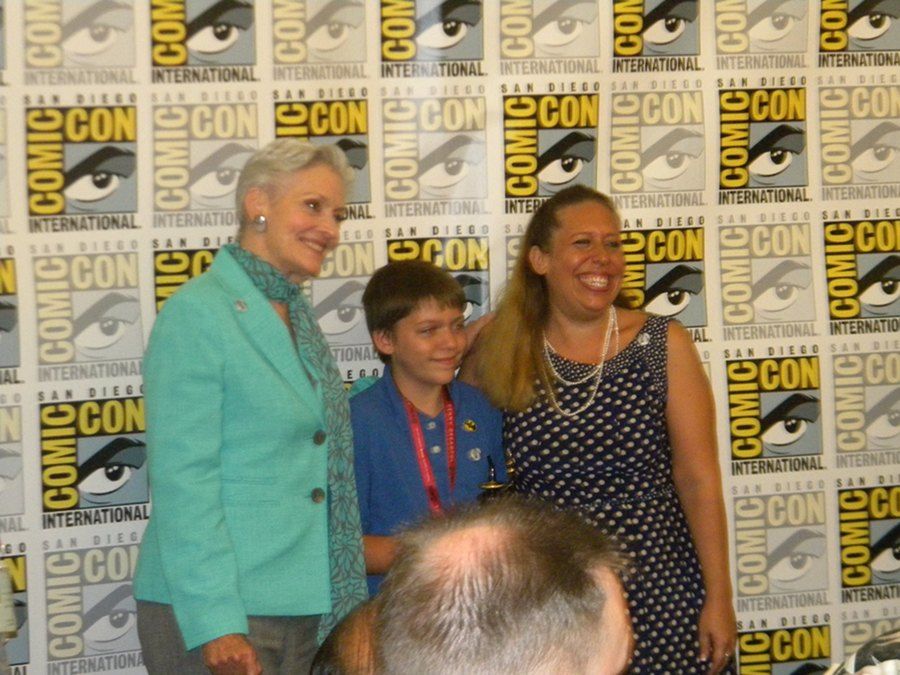During Comic-Con International in San Diego, DC Comics held a multitude of panels to celebrate the 75th anniversary of Batman, but perhaps no celebration was more anticipated than the panel honoring Bill Finger -- the legendary co-creator of Batman -- as organized by fans, friends and historians.
While Finger himself was never a guest of Comic-Con while alive, the show welcomed Finger's granddaughter Athena Finger and great-grandson Benjamin who took the stage to accept a version of the Bill Finger Award -- the hall of fame-like honor for comic writers given at every year's Eisner Awards. Joining the family were a multitude of Batman creators, fans and historians including Finger biographer Marc Tyler Nobleman, writer Mark Evanier, producer Michael Uslan, actress Lee Meriwether, Jerry Robinson's son Jens Robinson and journalist and "Batman And Me" co-author Tom Andrae. Aside from the panelists, a number of folks connected to Batman were in attendence including legendary writer and editor Denny O'Neil and writer Alan Burnett.
The proceedings started with a video honoring Finger's many contributions to the Batman mythos as seen in the various film and television adaptations over the years including the origin of the character involve the death of his parents, Joker, Robin, Penguin, Catwoman, the Riddler, Alfred, Two-Face, Mr. Freeze and many other elements of the wider DC Universe including the co-creation of the Golden Age Green Lantern Alan Scott.
Dr. Travis Langley -- a psychologist and Batman expert -- led the ensuing discussion. Few of the panelists had met Finger during his lifetime, though Uslan spoke of meeting the man twice while Evanier said that he met him once in a short enough meeting "to gush at him and discuss the New York City transit system."
The question of Finger's contributions and legacy went to Nobelman who noted that as the original writer of Batman he was also largely responsible for refining Bob Kane's initial sketch into the real Batman fans know today. The author said that the wide reach of Fingers imagination meant that the past two Batman movies didn't even need "Batman" in the title since "even Bill's nicknames were that recognizable."
Robinson related his father's memories of Finger. As the first artist of Kane's Golden Age shop, the elder Robinson was a driving force behind much of Batman's early world including the visualization of the Joker. The younger Robinson stressed that the early adventures were only the result of wide collaboration between all three of the original hangs that worked on the series where Kane would do rough visual outlines to be turned into full comics (often with a lot of redrawing) by the others. Robinson and Finger worked closely together to make the stories what they were, the son explained.
Athena Finger said, "Bill was hidden from the world." For most of his comics career, the notoriously thorough writer often locked himself away to get his scripts turned in. Even today, the few surviving artists who worked from Finger's scripts like Joe Giella rarely met or interacted with Bill but instead received his completed stories to draw from. Langley said it took historians many years to track down info on Finger and his work.
Finger's association with Batman went over decades as he also co-wrote an episode of the 1966 "Batman" TV show with friend Charles Sinclaire who is alive today and gifted Athena with a rare sculpture that Finger made while alive. The episode, featuring the Clock King was one of the few times that Finger was credited directly on a Batman story he wrote. This was some small consolation for Finger who had recently been removed from his comics scripting duties after years working in obscurity.
Uslan offered an impassioned appraisal of Finger's work including his time on the "new look" Batman stories that came out 50 years ago. That era of stories was in the early days of comics fandom, kids like Uslan never knew the names of the creators, though they knew that there were some who ghosted on the books that were great while others where lacklustre. Finger's own story work had thematic and dramatic connections between them that tipped readers off that it was the same man -- usually involving giant props and elaborate death traps. "It was a sense of fun. It was a sense of the visual...almost always with the most grotesque supervillains," the producer said.
Uslan finally learned about the men behind the comics when he got access to some early art given away by DC to fans who would come to the offices. When visiting, Uslan snuck up behind an in-the-office Finger (sharing space with artist Murphy Anderson) and introduced himself. Finger identified himself as a person who'd been writing Batman comics from the very beginning yet he never called himself the creator or took too much credit.
Soon after that first meeting, the very first comic convention was held in New York during which a 13-year-old Uslan met up with his comic book mentor -- writer Otto Binder -- in passing and was intoduced again to Finger by Binder who called him "the creator of Batman."
Nobleman said that in his research, he found evidence of that day when Binder and Finger were sitting together in the bar in the form of a short newspaper article on the pair of creators. However, it wasn't until 1995 that Finger would get his name in the New York Times in connection with Batman.
Andrae spoke to Finger's status as a pioneer in understanding the visual nature of comics. Like Will Eisner, he had a flair for the dramatic possibilities in the medium, the writer said, and he would often put together photographic research for his artists to draw his giant props and wild ideas accurately. The writer went on to talk about Orson Wells' love of comics, noting that the clock fight at the end of Wells' "The Stranger" is a near direct lift from an early Finger Clock King story in "Batman." "So Bill was not just a writer. He was also a visual artist who inspired the whole atmospher of Batman," Andrae said.
Denny O'Neil was then called up on stage to talk about the time he met Finger. "I was the newest kid on the block, about maybe six weeks out of the job as a reporter in a small town you've never heard of...and I ended up in New York as a comic writer knowing nothing about comic books," he said. Finger took O'Neil out for dinner and taught him the basics of the NYC comics business and the ins and outs of the comics writing craft. "We had a long, pleaseant, friendly evening...I wish that I had sought out Bill to spend more time with him. And although I know it would have been impossible when I was Batman editor, I wish I would have tried harder to get him credit...he was creating the artform at $5 bucks a page...the comics have structures and opportunities that did not exist in other mediums, and those guys [like Finger] were creating an artform for very little pay."
Meriwether spoke to the fans of Batman. "I really can say that they're all enthusiastic. They loved the movie and loved the series...they're always excited and intruiged by everything. They are very, very loyal. And many, many of them will say 'My babysitter or my grandfather or [whoever] made me sit down and watch your 'Batman' movie." She expressed pride in the assembled fans to work to get the story on Fingers legacy straight and make his work known around the world.
Evanier spoke to the Finger Award, saying that writer Arnold Drake suggested the award years ago at San Diego. "We should have an award called the Finger -- which he then demonstrated -- for all the guys who never got the credit they deserved," recalled Evanier of the moment. He also credited Robinson not just with being a partner to Kane but also for largely being the man known to readers as Bob Kane. "Nobody every doubted Jerry Robinson because he was so honorable and so humble," Evanier said of the artist who's final push helped get the Award established.
Evanier met Finger himself around 1973 while visitng the DC Comics offices. Nelson Bridwell told Evanier that the quiet man he saw wandering through the halls was Finger, and so Evanier ran down to the lobby to catch him before he left the building so he could say, "I've been plaegarizing you for years!"
Athena said that for years, people she met never believed her when she said that her grandfather had co-created Batman. Nobleman connected with her in 2007 when she was a bit gunshy about talking about her grandfather in public, but over the years she's taken a more active role in promoting her grandfather's legacy, saying that the 75th anniversary was the perfect moment for her to start doing cons in his honor. She did meet Robinson and Uslan at the premier of "The Dark Knight" where the producer introduced the pair to Christopher Nolan and the cast who were gracious and thankful for the contributions of the early, forgotten Batman creators.
Young Benjamin said that even as far back as Kindergarten he had trouble getting friends to understand or accpet how important his great-grandfather was, but after Nobleman's biography was carried in his school library, he was proudly able to tell his peers about his family legacy.
Andrae worked hard in his text of "Batman And Me" to get Finger more credit than Kane had ever given him in the past. "Bob started to feel guilty and wanted to put Bill's name on the strip, which he had never done. He talked about Bill's working on the costume, but he didn't say too much," Andrae said, adding that as the process went along, he began to use quotes from Jim Steranko's "History of Comics" to fill in the rest of the story. Eventually, Kane came back and said, "There's too much about Bill in there. Remember, I created Batman." Andrae said that while Kane expressed that desire to get Finger a byline, he backed away on it before his death because he was worried about the legal ramifications of giving that credit.


